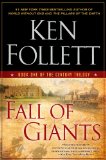Summary | Excerpt | Reading Guide | Reviews | Beyond the Book | Read-Alikes | Genres & Themes | Author Bio

Critics' Opinion:
Readers' Opinion:
First Published:
Sep 2010, 985 pages
Paperback:
Aug 2011, 1008 pages
 Book Reviewed by:
Book Reviewed by:
Sarah Sacha Dollacker
Buy This Book
This article relates to Fall of Giants
Ethel and Maud's agitation for women's suffrage is a critical element in Fall of Giants. According to Follett: "of all the massive changes that took place in the 20th century, the biggest was equality for women."
Though there were instances of agitation for a woman's right to vote in Britain prior to the formation of the National Society for Women's Suffrage (NSWS), women's suffrage as a national movement did not begin until 1872 when the NSWS brought women's suffrage to national attention.  The NSWS was critical in bringing the movement forward, but little was accomplished through their constitutional efforts until a militant campaign was adopted with the formation of the Women's Social and Political Union (WSPU) by Emmeline Pankhurst and some colleagues in 1903.
The NSWS was critical in bringing the movement forward, but little was accomplished through their constitutional efforts until a militant campaign was adopted with the formation of the Women's Social and Political Union (WSPU) by Emmeline Pankhurst and some colleagues in 1903.
Until the formation of the WSPU, the women's suffrage campaign had been a loosely organized group of women primarily from the landed class who were largely ineffective in garnering attention. The WSPU drew these smaller groups together into an organized band that used militant tactics, such as demonstrations, stone-throwing, arson, window-smashing, and hunger strikes, to draw public notice.
The WSPU was so successful in creating public awareness that Parliament was forced to pass a law to combat their disturbance. The Cat and Mouse Act of 1913 legalized hunger-strikes. Prior to 1913, hunger-strike prisoners were force-fed in prison, leading the protesters to claim governmental abuse while incarcerated. The Act (properly known as the Prisoners, Temporary Discharge for Health Act) mandated that no hunger-strike prisoner was to be force-fed. The prisoners were to be held in prison until they were very weak, at which point they were to be released to recover at home. Ultimately, the Act caused the liberal government to lose support, but it is unclear if the resulting sympathy (particularly among male voters) for suffragettes would have helped to win the vote because the outbreak of war in 1914 put WSPU activities on hold.
 Emmeline Pankhurst, and her daughter Christabel, who was closely involved in the movement, believed that the Germans were a dire threat to England and convinced the rest of the WSPU to suspend activities until the end of the war. Not everyone in the WSPU agreed with this decision but, ironically, the suspension of militant campaigning in favor of aiding the war effort may have done more to argue for women's suffrage than any other tactic.
Emmeline Pankhurst, and her daughter Christabel, who was closely involved in the movement, believed that the Germans were a dire threat to England and convinced the rest of the WSPU to suspend activities until the end of the war. Not everyone in the WSPU agreed with this decision but, ironically, the suspension of militant campaigning in favor of aiding the war effort may have done more to argue for women's suffrage than any other tactic.
British Women assumed many of the roles vacated by men sent to fight in World War I, with the number of women employed increasing from 3.2 million in July 1914 to 4.8 million in January 1918. Nearly 200,000 women worked in government departments, and over 700,000 worked in the munitions industry. Industries that had previously excluded women now embraced them, and there was a particular demand for women to work in the dangerous coal and shipbuilding industries.
Women's work during World War I changed the way their roles were viewed. Political movement towards women's suffrage began towards the end of the war, and in 1918 Parliament granted the vote to women over 30 who were householders, the wives of householders, occupiers of property with an annual rent of 5 pounds, or graduates of British universities. All British women were finally granted the right to vote on the same terms as men in 1928.
Images: Top: Emmeline Pankhurst (c.1913). Bottom: Christabel Pankhurst. All of Emmeline's children were involved with the women's suffrage movement but Christabel, Emmeline's favorite, was the most involved, spending almost 15 years working by her mother's side for the cause.
Filed under People, Eras & Events
![]() This "beyond the book article" relates to Fall of Giants. It originally ran in October 2010 and has been updated for the
August 2011 paperback edition.
Go to magazine.
This "beyond the book article" relates to Fall of Giants. It originally ran in October 2010 and has been updated for the
August 2011 paperback edition.
Go to magazine.





The Flower Sisters
by Michelle Collins Anderson
From the new Fannie Flagg of the Ozarks, a richly-woven story of family, forgiveness, and reinvention.

The House on Biscayne Bay
by Chanel Cleeton
As death stalks a gothic mansion in Miami, the lives of two women intertwine as the past and present collide.

The Funeral Cryer by Wenyan Lu
Debut novelist Wenyan Lu brings us this witty yet profound story about one woman's midlife reawakening in contemporary rural China.
Your guide toexceptional books
BookBrowse seeks out and recommends the best in contemporary fiction and nonfiction—books that not only engage and entertain but also deepen our understanding of ourselves and the world around us.